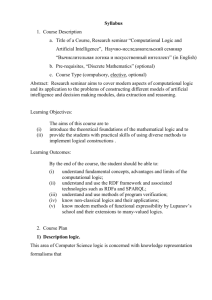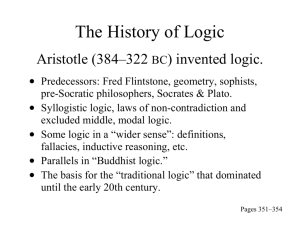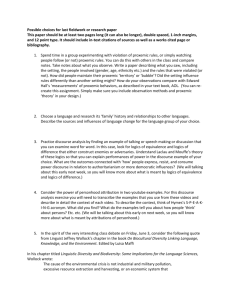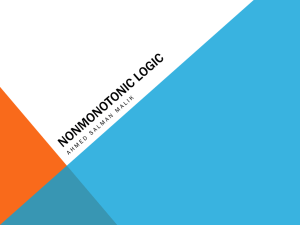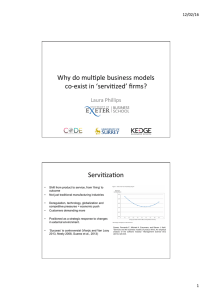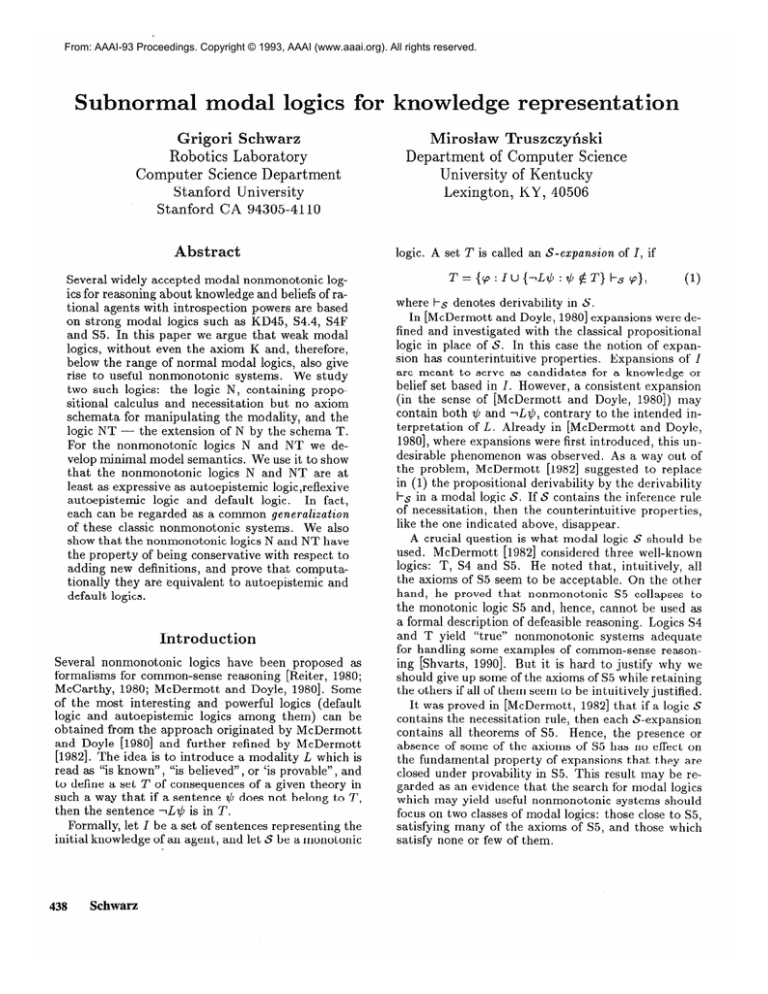
From: AAAI-93 Proceedings. Copyright © 1993, AAAI (www.aaai.org). All rights reserved.
Subnormal
modal logies
Grigori Schwarz
Robotics Laboratory
Computer Science Department
St anford University
Stanford CA 94305-4110
Abstract
Several widely accepted modal nonmonotonic
logits for reasoning about knowledge and beliefs of rational agents with introspection
powers are based
on strong modal logics such as KD45, S4.4, S4F
and S5. In this paper we argue that weak modal
logics, without even the axiom K and, therefore,
below the range of normal modal logics, also give
rise to useful nonmonotonic
systems.
We study
two such logics:
the logic N, containing
propositional calculus and necessitation
but no axiom
schemata for manipulating
the modality, and the
logic NT - the extension of N by the schema T.
For the nonmonotonic
logics N and NT we develop minimal model semantics.
We use it to show
that the nonmonotonic
logics N and NT are at
least as expressive as autoepistemic
logic,reflexive
autoepistemic
logic and default logic.
In fact,
each can be regarded as a common generalization
of these classic nonmonotonic
systems.
We also
show that the nonmonotonic
logics N and NT have
the property of being conservative with respect to
adding new definitions, and prove that computationally they are equivalent to autoepistemic
and
default logics.
Introduction
Several nonmonotonic
logics have been proposed as
formalisms for common-sense
reasoning [Reiter, 1980;
McCarthy,
1980; McDermott
and Doyle, 19801. Some
of the most interesting
and powerful logics (default
logic and autoepistemic
logics among them) can be
obtained from the approach originated by McDermott
and Doyle [1980] and further refined by McDermott
[1982]. Th e 1‘d ea is to introduce a modality L which is
read as “is known”, “is believed”, or ‘is provable”, and
to define a set T of consequences
of a given theory in
such a way that if a sentence + does not belong to T,
then the sentence ~L$J is in T.
Formally, let I be a set of sentences representing the
initial knowledge of an agent, and let S be a monotonic
438
Schwarz
Miroslaw Truszczyriski
Department of Computer Science
University of Kentucky
Lexington, KY, 40506
logic.
A set T is called an S-expansion
T = {p : I u {lL$
of I, if
: $ @ T} l--s p},
(1)
where t-s denotes derivability in S.
In [McDermott and Doyle, 19801 expansions were defined and investigated with the classical propositional
logic in place of S. In this case the notion of expansion has counterintuitive
properties.
Expansions
of I
are meant to serve as candidates for a knowledge or
belief set based in I. However, a consistent expansion
(in the sense of [McDermott
and Doyle, 19801) may
contain both ti and lL$,
contrary to the intended interpretation
of L. Already in [McDermott
and Doyle,
19801, where expansions were first introduced, this undesirable phenomenon was observed. As a way out of
the problem, McDermott
[1982] suggested to replace
in (1) the propositional
derivability by the derivability
l-s in a modal logic S. If S contains the inference rule
of necessitation,
then the counterintuitive
properties,
like the one indicated above, disappear.
A crucial question is what modal logic S should be
used. McDermott
[1982] considered three well-known
logics: T, S4 and S5. He noted that, intuitively, all
the axioms of S5 seem to be acceptable.
On the other
hand, he proved that nonmonotonic
S5 collapses to
the monotonic logic S5 and, hence, cannot be used as
a formal description of defeasible reasoning. Logics S4
and T yield “true” nonmonotonic
systems adequate
for handling some examples of common-sense
reasoning [Shvarts, 19901. But it is hard to justify why we
should give up some of the axioms of S5 while retaining
the others if all of them seem to be intuitively justified.
It was proved in [McDermott,
19821 that if a logic S
contains the necessitation
rule, then each S-expansion
contains all theorems of S5. Hence, the presence or
absence of some of the axioms of S5 has no effect on
the fundamental
property of expansions that they are
closed under provability in S5. This result may be regarded as an evidence that the search for modal logics
which may yield useful nonmonotonic
systems should
focus on two classes of modal logics: those close to S5,
satisfying many of the axioms of S5, and those which
satisfy none or few of them.
So far, logics close to S5 have received substantially more attention
most notably the modal logics
KD45, S4.4, S4F. It has been shown [Shvarts, 1990;
Schwarz, 1991a; Truszczyfiski,
1991b] that if we disregard inconsistent expansions, the nonmonotonic
modal
logic KD45 is equivalent to the celebrated
autoepistemic logic by Moore, logic S4.4 is equivalent to the autoepistemic logic of knowledge introduced in [Schwarz,
1991a], and Reiter’s default logic can be naturally embedded in the nonmonotonic
logic logic S4F, which, in
turn, has a natural interpretation
as a logic of minimal
(or grounded) knowledge [Schwarz and Truszczynski,
19921.
The logics KD45, S4.4 and S4F share several common features. They are close to S5 and admit natural
epistemic interpretation
as logics of belief (KD45), true
belief (S4.4), k nowledge (S4F).
F inally, each is maximal with respect to some property of nonmonotonic
logics. The logics KD45 and S4.4 are maximal with
respect to the property of producing exactly one expansion for modal-free theories [Schwarz, 1991a]. The
logic S4F is a maximal logic for which theories without positive modalities (like the theory (Lp > p} considered by Konolige [1988]) have a unique expansion
[Schwarz and Truszczyriski,
19921.
Logics close to S5 are normal, that is, they contain
the necessitation
rule and the modal axiom scheme
L(cp > T+!J)> (Lp > L+). Normal modal logics possess
an elegant and natural semantics, namely, the possible
world semantics introduced by Kripke [1963]. Kripke
semantics makes it easy to investigate normal modal
logics, and was fruitfully exploited in investigations
of nonmonotonic
logics based on normal modal logits [McDermott,
1982; Moore, 1984; Levesque, 1990;
Shvarts, 1990; Marek et ad., 19911.
In this paper we will focus our attention
on the
other end of the spectrum of modal logics.
We will
consider nonmonotonic
logics that correspond to weak
modal logics that satisfy none or only few axioms of
S5. Namely, we will consider logics not satisfying the
axiom K. Such logics ar% not normal.
We will refer to them as subnormal.
Some non-normal
logics
have been investigated
by philosophers
[Kripke, 1965;
Segerberg,
19711. (In fact, the first three modal logics
introduced, Sl, S2 and S3, were not normal; see [Feys,
19651 for a historical survey). Because these logics were
aimed at eliminating the so-called “paradoxes of material implication”,
they do not contain the necessitation
rule, but contain the axiom K or some of its weaker
versions. Hence, they are different from the subnormal
modal logics considered in this paper.
There are at least two reasons why it is important
to consider nonmonotonic
logics based on weak modal
logics. First, according to one of the results of [McDermott, 19821, if T and S are two modal logics such
that T E S C 5’5, then each I-expansion
is an Sexpansion but the converse does not hold in general.
In other words, when we replace a logic S by a weaker
one, say 7, then often some of the expansions disappear. Hence, using weak modal logics in the schema
(1) offers a possible solution to the problem of ungrounded expansions (see Konolige [1988]). Secondly,
the assumption
that a reasoner has a power of reasoning in a strong modal logic such as KD45, S4.4 or
S4F may not be a realistic one. Therefore, it is important to study what types of reasoning can be modeled
if weak modal logics are used instead.
It turns out
that in the nonmonotjonic
case we do not loose anything by restricting
an agent’s reasoning capabilities.
Namely, and it is perhaps the most surprising result
of our work, we show that nonmonotonic
modal logics
KD45 and S4.4 (that is, essentially, autoepistemic
logic
and autoepistemic
logic of knowledge) can be embedded into nonmonotonic
modal logics corresponding
to
some very weak modal logics containing necessitation.
A similar result is also known to hold for default logic
[Truszczynski,
1991b].
In this paper we study two modal logics. Both logits are assumed to be closed under the uniform substitution rule and contain propositional
calculus and
the rule of necessitation.
These requirements
specify
It
the first of them, the logic N of pure necessitation.
was first introduced and investigated in [Fitting et al.,
19921 but its nonmonotonic
counterpart had been studied earlier in [Marek and Truszczynski,
19901. The
second logic is obtained from N by adding the axiom
schema T: Lp > p. It will be referred to as t#he logic
NT.
The logic N is clearly distinguished among all modal
logics contained in S5 and containing
the necessitation rule. It is the weakest one. It is also the weakest
logic without counterintuitive
expansions containing 1c,
and ~LI,/I. It is interesting to note that N-expansions
were introduced already in the pioneer work of Moore
[1985] under th e name “modal fixed points”.
He also
noticed that all N-expansions
are stable expansions,
but not vice versa, and suggests the interpretation
of
“nonmonotonic
N” as a logic of “justified belief”.
In
[Marek and Truszczynski,
19901 nonmonotonic
N was
studied in detail under the name strong autoepistemic
logic.
The reasons we are interested in the logic NT are
the following.
First, while KD45 is quite commonly
accepted as a logic of belief, there is no consensus as
for the “right” modal logic of knowledge. For example,
in the monograph [Lenzen, 19781 among all the modal
axioms of S5 only the axiom T is essentially unquestionable (you cannot know a false proposition, you can
only believe that it is true).
Hence, NT may be regarded as a part of any reasonable logic of knowledge.
Another reason is more formal in nature.
Often
modal formulas describing examples of common-sense
reasoning have no nested modalities, and no negative
occurrences of L. For example, “p is true by default”
is usually expressed as 1Llp
> p. For such theories
many nonmonotonic
logics coincide. For example, it is
NonmonotonicLogic
439
proved in [Marek and Truszczyfiski,
19901 that for theories without negative occurrences
of L, S-expansions
coincide for all modal logics S between N and KD45.
Similarly, S-expansions
coincide for all modal logics S
between NT and S4.4. Recall that KD45 and S4.4 are
maximal logics which do not produce “ungrounded”
expansions for objective theories. Thus, it seems that
T is, probably, the only axiom which makes a difference. Hence, it is important
to study the nonmonotonic modal logic corresponding
to the weakest modal
logic containing the schema T.
The problem with logics like N or NT is, that they
are not closed under the equivalence substitution rule.
For example, I-N p G lip,
but I+N Lp E Lllp.
This
means, that algebraic semantics for such logics are impossible (if we want G to be interpreted
as equality
in the algebra of truth values). On the other hand, a
Kripke-style semantics for N has been found in [Fitting
et al., 19921. The key idea used in this paper was to
treat N as a logic with infinitely many modalities, so L
in Lp and L in L$ represent two different modalities,
if cp and $ are syntactically
different.
For a long time nonmonotonic
modal logics, even
if an underlying
modal logic was normal, lacked an
intuitively
clear semantics.
Recently,
such a semantics has been found [Schwarz, 19921. In this paper we
combine ideas from [Fitting et al., 19921 and [Schwarz,
19921 and obtain a possible world semantics for the
nonmonotonic
logics N and NT. We apply these semantics to prove that the nonmonotonic
modal logics
KD45 and S4.4 can be embedded into the nonmonotonic logics N and NT. What is more, the embeddings
are very simple. For example, to embed the nonmonotonic logic KD45 (that is, the autoepistemic
logic) into
the nonmonotonic
logic N, it is enough to replace each
occurrence
of L with 1LlL.
Consequently,
the nonmonotonic logic N is at least as expressive as nonmonotonic KD45:
the modality
1LlL
can be viewed as
the “modality of nonmonotonic
KD45”.
In the same
time, no faithful embedding
of nonmonotonic
N (or
NT) into nonmonotonic
KD45 is known so far. We
regard our “embedding”
results as the most important results of our paper. They show that subnormal
modal logics such as N and NT can easily be used (in
the nonmonotonic
setting) to simulate other nonmonotonic formalisms
and, thus, are viable and powerful
knowledge representation
tools.
Perhaps
even more importantly,
the expressive
power of nonmonotonic
logics N and NT comes at no
additional cost in terms of computational
complexity,
In this paper we study computational
properties of the
logics N and NT and their nonmonotonic
counterparts.
It turns out that the logics N and NT behave similarly
to logics close to S5 (such as S5 itself, KD45, S4.4
and S4.3.2).
Namely, in the monotonic case, it is NPcomplete to decide if a theory is consistent in N (or
NT) and it is Cr-complete
to decide existence of an
N( NT)-expansion.
Since the complexity of reasoning
440
Schwan
with autoepistemic
and default logics is also located on
the second level of the polynomial hierarchy [Gottlob,
19921, nonmonotonic
logics N and NT are computationally equivalent to these two classic nonmonotonic
systems. It is worth noting that logics “in the middle”
of the spectrum,
that is, those containing K but still
“far away” from S5, such as K, or T, are much more
complex (satisfiability
is PSPACE-complete).
Hence,
our complexity results provide yet another justification
for focusing on logics that are either very weak (subnormal) or very strong (close to S5).
Some properties which are quite easy to prove for
monotonic modal logics are not at all obvious for nonmonotonic modal logics. For example, adding explicit
definitions of the form q E cp does not affect the q-free
fragment of the set of logical consequences of a theory.
Some nonmonotonic
logics, for example logic of moderately grounded expansions,
do not have this property [Schwarz, 1991b].
It is rather unfortunate
since
it means that simply introducing
a new notation can
change the fragment of agent’s knowledge that does
not involve this new notation at all. In this paper we
prove that for every (even subnormal)
modal logic S,
introducing
an explicit definition of the form q E cp
does not affect the q-free fragments of S-expansions.
Kripke semantics
for the logics N and
NT
In this section we recall the semantics introduced in
19921 for the
[Fitting et al., 19921 and [Truszczynski,
logics N and NT.
By a multi-relationad Kripke model (or, simply, m-r
Kripke model) we mean a triple
where M is a nonempty set, commonly referred to as
the set of (possible) worlds of a model, R,, where cp E
LL, is a binary relation on M, and V is a function on
AJ, called a vuduution function, assigning to each world
(Y E iU a subset V(a) of propositional
variables of the
language.
Hence, the only difference between multirelational Kripke models and standard Kripke models
is that the former have infinitely many accessibility
relations while the latter have just one.
The
notion
of truth
of a formula
cp in a
world CY of a multi-relational
Kripke model M =
(MY mf&ECL
YV), denoted (M, a) b cp, is defined
recursively on the length of a formula. The only case
where the definition differs from the usual one is the
case of modal operator L. If (o is of the form L$, we
define (M, o) + cp if and only if for every p E M such
that cy%/? we have (M,P) b $.
A formula ‘p is valid in a multi-relational
Kripke
modelM
if(M,a)
)=cpforeverya,EM.
Theorem 1 ([Fitting
et ad., 19921) Let I E LL and
let cp E ,CL. Then I I-N cp if and only if cp is valid in
every multi-relational Kripke model in which I is valid.
Kripke model is reflexive
A multi-relational
of its accessibility
rel ations is reflexive.
if each
Theorem 2 ([Trusaczyriski,
19921) Let I C /ZL
Then I kNT cp if and only if cp is
and let cp E CL.
valid in every reflexive multi-relational
Kripke model
in which I is valid.
Minimal model semantics for the
nonmonotonic
logics N and N
We will follow the approach of [Schwarz, 19921, where
minimal model semantics
was proposed for the nonmonotonic
logic S for a wide class of normal modal
logics. Speaking more precisely, we will consider universal S5-models
as special m-r Kripke models (with
the same, universal, accessibility relation for every formula) and we will adapt the notion of minimality introduced in [Schwarz, 19921 to the class of all m-r models
and the class of all reflexive m-r models.
Let M’
=
(&J’, {R$}+,EtL,Vr)
and M”
=
(AP, iVP’ x M”, V”) be an m-r Kripke model and
Kripke S5-model,
respectively.
Assume also that M’
and M” are disjoint. By the concatenation
of M’ and
M”, denoted M’o M”, we mean an m-r Kripke model
(M’ u Ml’, (R&EL~.
, V’ u V”),
where R, = R; u ((M’ u M”) x M”).
A Kripke SEi-model M is N-minimal (NT-minimal)
model of I, if M b I and there does not exist an m-r
Kripke model (reflexive m-r Kripke model) M’ such
that
1. M’oM
+I,
2. for some /? E M’, Vp’differs from Vz for all CYE M”.
Speaking informally, an S5-model M” is N-minimal,
if it is not a common final cluster for all the accessibility relations of any N-model
with at least one world
different from all the worlds of M”.
This notion of rninimality may seem a bit exotic at
first. In particular,
it is different from the notion of
a minimal universal S5-model as discussed by Halpern
and Moses [1985] w h o consider minimality in the class
of universal S5-models with respect to the inclusion relation on the sets of worlds of models.
On the other
hand, a careful examination
of our notion of minimality shows that it is very closely related to the notion of
minimality used by Moore [1984] and Levesque [1990]
in their characterizations
of stable expansions in the
autoepisternic
logic. We refer the reader to [Schwarz,
1992; Schwarz and Truszczyliski,
19921 for a more detailed discussion of the minimal knowledge paradigm
and comparisons
between existing approaches.
Similar intuitions behind the notions of minimality studied
here will be provided in the full paper.
Theorem 3 For every theory I C CL and for every
consistent theory T C ,CL, T is an N-expansion for I
if and only if T is the set of all formulas valid in some
N-minimal model for I.
Theorem 4 For every theory I E ,CL and for every
consistent theory T s ,CL, T is an NT-expansion
for I
if and only if T is the set of all formulas valid in some
NT-minimal
model for I.
These two results show that the semantic notion of
N- (NT-) minimal models is in the exact correspondence with the syntactic notion of an N- (NT-) expansion as specified by the equation (1).
Expressive power of nonmonotonic
logics N and NT
In the monotonic
setting the logics N and NT are
very weak. In fact, the logic N is the weakest modal
nonmonotonic
logic containing necessitation.
Despite
of that, nonmonotonic
logics N and NT are powerful
nonmonotonic
formalisms.
It is known that default
logic can be embedded into the nonmonotonic
logics
N and NT so that there is a one-to-one
correspondence between extensions
of default theories and Nand NT-expansions
of the corresponding
modal theories [Truszczyriski,
1991b; Truszczyriski,
1991a]. The
main goal of this sect ion is to show that also the autoepistemic logic can be embedded into the nonmonotonic modal logics N and NT.
The autoepistemic
logic represents the modality L
as the belief modality.
The interpretation
that logits N and NT give to the operator L is more that of
knowledge than belief. Having a formula Lv in the set
of consequences
of a theory I (in either of these logits) means that we are able to provide a very rigorous
proof of Lp from our initial assumptions I. In the case
of logic N, in such a proof we only use propositional
calculus and necessitation.
Hence, in particular, if I is
modal-free, the only way to have a formula LAY in the
set of consequences of I is to have (o among the propositional consequences of I. In the case of the logic NT
the situation is similar. The only difference is that we
are also allowed to make use of the axiom schema T
(Lp > p) which seems to be an uncontroversial
property of knowledge modality.
For a formula cp, by (Pi we denote the result of simultaneously
replacing each occurrence of L in cp by
1LlL.
For a theory I, we define IN = {cpN: cp E I}.
The following theorem shows that under the mapping I t--+ IN, stable expansions for I are precisely
N( NT)-expansions
for IN.
Theorem 5 Let T & .CL be consistent.
Let I & ,CL.
Then T is an autoepistemic
expansion for a theory I
if and only if T is an N-expansion for IN, and if and
only if T is an NT-expansion
for IN.
A similar correspondence
between autoepistemic
logic and reflexive autoepistemic
logic (the nonmonotonic logic S4.4) under the same translation
has been
discovered earlier in [Schwarz, 1991a]
Reflexive autoepistemic
logic of [Schwarz, 1991a] is
faithfully embedded into Moore’s logic by means of the
NonmonotonicLogic
441
translation
which rewrites each &J as cp A Lp. Combaining these two translations,
we obtain easily the
translation
of reflexive autoepistemic
logic into nonmonotonic N, too.
Algorithmic
aspects of reasoning with
nonmonotonic
logics N and NT
Reasoning in modal logics is often very complex.
For
example, it is PSPACE-complete
to decide whether for
a given theory I and a formula cp, I l-s* ‘p (where
t--s4 denotes the provability operator in the logic S4).
For stronger logics such as KD45, S4.4, S4F and S5
the problem of deciding whether a formula cp is a consequence of a theory I becomes easier namely, NPcomplete (assuming PSPACE
does not collapse to the
first level of the polynomial hierarchy).
In this section,
we will study the complexity of reasoning in the logics
N and NT.
Theorem
6 Problems of deciding for a given finite set
I of formulas,
if I is consistent with logic N, or with
logic NT, are NP-complete
(in the length of I). Problems of deciding, for given finite set I and formula cp,
if I f-s cp, is co-NP-complete,
for S being N or NT.
Our complexity
results have direct implications
of
on the complexity
of reasoning in nonmonotonic
logits N and NT. The results for the case of the logic N
have been obtained by Gottlob [1992]. Therefore,
we
derive here only the results for the nonmonotonic
logic
NT. As the main tool in our argument we will use
a syntactic
characterization
of NT-expansions
which
follows from general results given in [Shvarts,
1990;
to
Marek et al., 19911. Adapting this characterization
the case of logic NT, we obtain complexity results for
the following algorithmic problems associated with the
nonmonotonic
logic NT:
EXISTENCE
Given a finite theory
if A has an NT-expansion;
A C LK,
decide
IN-SOME
Given a finite theory A C ,CK and a formula cp E ICK, decide if cp is in some NT-expansion
ofA;
NOT-IN-ALL
Given a finite theory A & LK and a
formula cp E ,CK, decide if there is an NT-expansion
for A not containing cp;
IN-ALL
Given a finite theory A E ISK and a formula
cp E LK, decide if cp is in all NT-expansions
of A.
Theorem 7 Problems
NOT-IN-ALL
II{-complete.
EXISTENCE,
IN-SOME
and
are Er-corn-plete.
Problem IN-ALL is
For the case of the logic N the same complexity
results have been obtained by Gottlob
[1992]. Since
reasoning in default and autoepistemic
logics is also
ZF- or @-complete
(depending on the type of question) [Gottlob,
19921, it follows that computationally
our nonmonotonic
logics are equivalent to these two
“classic” nonmonotonic
formalisms.
442
Schwam
Explicit
definitions
All standard logics are conservative
with respect to
adding explicit definitions. Speaking informally, naming a formula by a new propositional
symbol does not
change the set of theorems in the original language.
Since logics are supposed to model general principles
of reasoning and be applicable in a wide spectrum of
domains, the property that the set of conclusions
is
(essentially)
invariant under new names seems to be
natural and desirable to have.
It is known (see [Schwarz and Truszczynski,
19921)
that those nonmonotonic
logics in the McDermott
and
Doyle’s family which are based on normal modal logits are conservative with respect to adding new names.
That is, after a new name is introduced,
each expansion of the resulting theory is a conservative extension
of an expansion of the original theory. In this paper
we will show, using different means than in [Schwarz
and Truszczyliski,
19921 (the proof given there does
not carry over to the case of subnormal modal logics)
that every modal nonmonotonic
logic in the family of
McDermott and Doyle, in particular the nonmonotonic
logics N and NT, share this desirable property.
For a theory I s CL, we define
IqJ
= I u {q f
rj).
Let p be a propositional
variable and let $ and cp be
formulas. we write @(p/p) to denote the result of substituting cp for p uniformly in $. Clearly, if p does not
occur in $J then ti(p/p)
= $. Let Q be an atom not
in LL and let 77 be a formula from ,CL. For a theory
T 2 LL define
TJTq = {Ic, E $:$(q/q)
where Li
denotes the extension
E T},
of the language
4.
CL by
The following theorem states that, nonmonotonic
and NT admit explicit definitions.
N
Theorem 8 Let S be a modal logic.
Let I C ,CL, A
theory S is an S-expansion
for Iqjn if and only if S =
Tq)q for some S-expansion
T of I. Moreover, S is a
conservative extension of T, that is, T is exactly the
q-free part of S.
Conclusions
In this paper we have studied the nonmonotonic
logits that can be obtained by the method of McDermott
and Doyle from two very weak modal monotonic logics:
the logic N of pure necessitation
and its extensions, the
logic NT. We argued that despite the fact that these
logics lack several of the axiom schemata that characterize properties of knowledge and belief, the resulting
nonmonotonic
systems are at least as suitable for representing these notions as are autoepistemic,
reflexive
autoepistemic
and default logics.
We developed a minimal model semantics for the
nonmonotonic
logics N and NT. We proved that autoepistemic logics can be embedded into either of these
two logics (the same result for the default logics has
been already known earlier).
We showed that both
our nonmonotonic
logics have a desirable property of
being conservative with respect to adding new names.
We also showed that reasoning with monotonic logics
N and NT is computationally
equivalent to reasoning
in propositional
logic, and established
the complexity
of reasoning with nonmonotonic
logics N and NT. Our
results show that the complexity of reasoning with nonmonotonic logics N and NT is located on the second
level of the polynomial hierarchy and, thus, is the same
as the complexity of reasoning with autoepistemic,
reflexive autoepistemic
and default logics.
Finally, nonmonotonic
logics N and NT are conservative with respect to adding explicit definitions.
All
these results indicate that nonmonotonic
logics N and
NT are viable and powerful nonmonotonic
formalisms.
Acknowledgements
The second author was partially supported by National
Science Foundation
under grant IRI-9012902.
References
Feys, R. 1965. Modal Logics. Louvain E. Nauwelaerts,
Paris.
Fitting,
M. C.; Marek, W.;
1992. Logic of necessitation.
Computation 21349-373.
and Truszczynski,
M.
Journal
of Logic and
Gottlob,
G. 1992. Complexity
results for nonmonotonic logics. Journal of Logic and Computation 2:397425.
Halpern, J.U. and Moses, U. 1985. Towards a theory
of knowledge and ignorance:
preliminary
report. In
Apt, K., editor 1985, Logics and Models of Concurrent Systems. Springer-Verlag.
459 - 476.
On the
Konolige,
K. 1988.
fault and autoepistemic
logic.
35~343-382.
relation between deArtificial Intelligence
Kripke, S. 1963. Semantical
analysis of modal logic
I: Normal modal propositional
calculi.
Zeitschrij?
fiir mathematische
Logic and Grunddagen der Mathematik 67 - 96.
Kripke, S. 1965. Semantical analysis of modal logic II:
Non-normal modal propositional
calculi. In Addison,
J.W.;
Henkin, L.; and Tarski, A., editors 1965, The
AmsterTheory of Models, volume 9. North-Holland,
dam. 206 - 220.
Lenzen, W. 1978. Recent Work in Epistemic Logic,
volume 30 of Acta Phidosophica
Fennica.
NorthHolland, Amsterdam.
Levesque, H. J. 1990. All I know: astudy in autoepistemic logic. Artificial Intelligence 42:263-309.
Marek, W. and Truszczynski,
M. 1990. Modal logic
for default reasoning. Annals of Mathematics and Artificial Intelligence
I:275 - 302.
Marek, W.; Shvarts, G.F.; and Truszczynski,
M. 1991.
Modal nonmonotonic
logics: ranges, characterization,
Conference
on
computation.
In Second International
Principles of Knowledge Representation
and Reasoning, KR ‘91, San Mateo, CA. Morgan Kaufmann.
395-404.
An extended version of this article will appear in the Journal of the ACM.
McCarthy,
monotonic
J. 1980. Circumscription
- a form of nonreasoning. Artificial Intelligence 13:27-39.
McDermott,
D. and Doyle, J. 1980. Nonmonotonic
logic I. Artificial Intelligence 13:41-72.
McDermott,
monotonic
29:33-57.
D. 1982. Nonmonotonic
Journal
modal theories.
logic II: Nonof the ACM
Moore, R.C. 1984. Possible-world
semantics for autoepistemic logic. In Reiter, R., editor 1984, Proceedings of the workshop on non-monotonic
reasoning.
editor, Read344-354.
(Reprinted
in: M.Ginsberg,
ings on nonmonotonic
reasoning. pages 137 - 142,
1990, Morgan Kaufmann.).
Moore, R.C. 1985. Semantical considerations
on nonmonotonic logic. Artificial Inteddigence 25:75-94.
Reiter, R. 1980. A logic for default reasoning.
ciad Intelligence 13:81-132.
Art@-
Schwarz, G.F. and Truszczynski,
M. 1992.
Modal
logic S4F and the minimal knowledge paradigm.
In
Proceedings of TARK 1992, San Mateo, CA. Morgan
Kaufmann.
Schwarz, G. 1991a.
Autoepistemic
logic of knowledge.
In Nerode, A.; Marek, W.; and Subrahmanian, V.S., editors 1991a, Logic Programming
and
Non-monotonic
Reasoning. MIT Press. 260-274.
Schwarz, G.F. 1991b. Bounding introspection
in nonmonotonic logics. In Third International
Conference
on Principles of Knowledge Representation
and Reasoning, KR ‘92, Cambridge, MA.
Schwarz, G.F. 1992.
Minimal model semantics for
nonmonotonic
modal logics. In Proceedings of LICS92.
Segerberg, K. 1971. An essay in classical modal logic.
Uppsala University, Filosofiska Studier, 13.
Shvarts, G.F. 1990. Autoepistemic
modal logics. In
Parikh, R., editor 1990, Proceedings of TARK 1990,
San Mateo, CA. Morgan Kaufmann.
97-109.
Truszczynski,
M. 1991a.
Embedding
default logic
into modal nonmonotoninc
logics.
In Nerode, A.;
Marek, W.; and Subrahmanian,
V.S., editors 1991a,
Logic Programming
and Non-monotonic
Reasoning.
MIT Press. 151-165.
Truszczynski,
M. 1991b. Modal interpretations
of default logic. In Proceedings of IJCAI-91,
San Mateo,
CA. Morgan Kaufmann.
393-398.
Truszczynski,
M. 1992. A generalization
of Kripke
semantics to the case of logics without axiom K. A
manuscript.
NonmonotonicLogic
443

